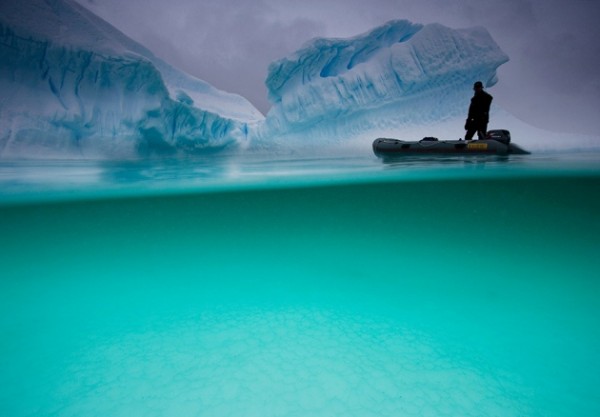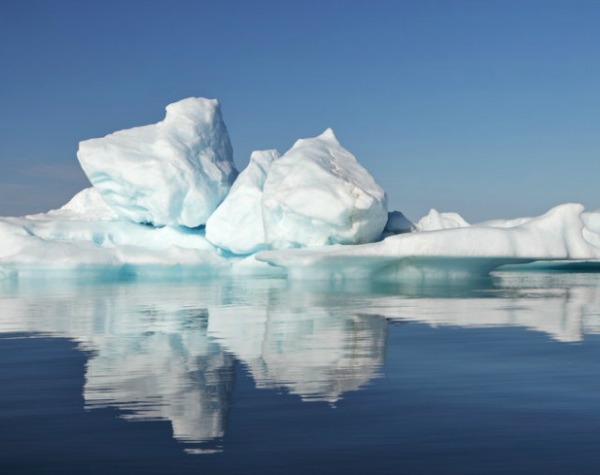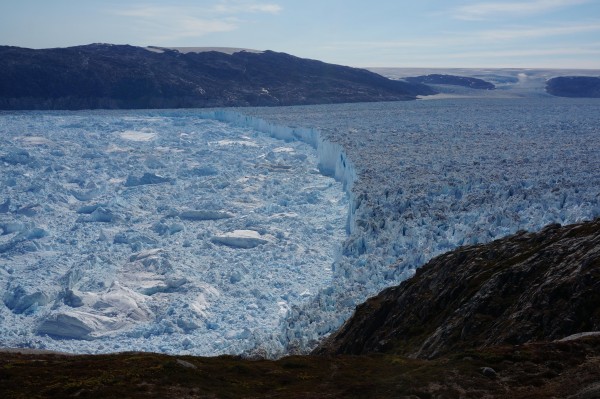Results 1 to 2 of 2
Thread Information
Users Browsing this Thread
There are currently 1 users browsing this thread. (0 members and 1 guests)
-
03-19-2016, 01:13 PM #1Senior Member

- Join Date
- Jan 2012
- Posts
- 4,815
Rutgers Report On Rising in Sea Levels
Detective story behind Rutgers report on rising sea levels
Updated: February 24, 2016 — 1:08 AM EST
Ice forms as the winter storm mixed with high tide caused flooding on Beach Avenue on Jan. 23, 2016, in Cape May.
Rte 10 -1/23/16 Cape May NJ
by Tom Avril, Staff Writer
Tide gauges show that average sea levels have been steadily rising since the late 1800s, a worrisome trend that scientists blame on emissions of heat-trapping greenhouse gases.
Human-caused rise in sea levels
But what about the centuries before then, when those gauges were mostly nonexistent?
Part of the answer, a team of researchers reported this week, lies in the salt marshes of South Jersey.
In a study published in Proceedings of the National Academy of Sciences, authors calculated sea levels over thousands of years by analyzing cores of sediment from the salt marshes and 23 other geological sites around the world.
The results were sobering.
The research team found it "extremely likely" that average sea levels rose faster in the 20th century than in any previous century since at least 800 B.C., at a rate of about 1.4 millimeters per year.
That may not sound like much, but it adds up - 5.5 inches during the 20th century, due to thermal expansion of seawater and the addition of liquid water from melting glaciers.
There is more to come, the authors added.
Even with strong cutbacks in burning fossil fuels such as gas and coal, sea levels could still rise anywhere from nine inches to two feet during this century, the scientists projected. With few or no reductions, average sea levels could rise by anywhere from 1.7 feet to more than four feet, they said.
"It clearly illustrates that we're living in an unusual time," said Rutgers University professor Benjamin P. Horton, one of the authors. "The paper also shows we're the cause of this."
Previous studies have calculated past sea-level rises for various locales, but this is the first to weave together a global picture with such rich sources of data spanning the globe, Horton said.
Lead author Robert E. Kopp, also of Rutgers, helped to develop the statistical approach for synthesizing the various geological records.
But first, someone had to get them - an often tedious process that took well more than a decade.
The scientists drilled for sediment cores along the Atlantic coast of North America, including at the Edwin B. Forsythe National Wildlife Refuge, north of Atlantic City. They analyzed other sediment data from such diverse sources as corals in the South Pacific and mangroves in Seychelles, in the Indian Ocean.
The sea level associated with each sample of sediment was calculated by counting the numbers of various one-celled organisms that lay within. Certain species of these creatures, called foraminifera, thrive at different levels of salinity, enabling scientists to discern the depth of the waters when the sediment was deposited.
The age of the sediments was then calculated by carbon-dating the remains of plants found at the same depths.
As a reality check, the scientists then looked to see if measurements from the modern tidal gauges matched data taken from sediments of similarly recent vintage. They did.
One source of data had a human origin: fish tanks made by the ancient Romans. The stone tanks were built to keep fish alive until it was time to prepare them. They were set just high enough in the water that fish could not swim out, but were low enough that the tanks received regular infusions of fresh tidal nutrients.
By measuring the current depth of the waters surrounding these tanks, scientists determined how much the seas had risen in the last 2,000 years, said Horton, a professor in the Rutgers department of marine and coastal science.
A key impact of rising seas is flooding. In a separate report posted this week on the educational site climatecentral.org, Kopp and others calculated that human-induced sea-level rise was responsible for more than 80 percent of the increase in "nuisance flood days" between two 30-year periods: 1955 to 1984 and 1985 to 2014.
Sea levels rise by varying amounts in different parts of the world due to factors other than climate change. For example, seas are rising faster in coastal New Jersey because the underlying land is subsiding.
So the scientists used statistics to extract a global average sea level over the centuries, said Kopp, an associate professor in the department of earth and planetary sciences.
"What we did was synthesize those local records to come up with a truly global curve," Kopp said.
One limitation: The scientists did not have high-resolution data from seas bordering Asia and most of South America. They hope that others in the field will develop new ways to measure the depths of those oceans in eons past.
But for now, the research provides the widest-yet picture of the rising seas, Horton said.
"It's really like a geological detective story," he said.
http://www.philly.com/philly/news/sc...ea_levels.html
-
04-02-2016, 05:27 PM #2Senior Member

- Join Date
- Jan 2012
- Posts
- 4,815
Sea-level rise underestimated by half?
A new study suggests that sea-level rise over the next 100 years could be nearly double earlier estimates.
 Recent studies suggest that the Antarctic ice sheet is much less stable than scientists once thought. Photo: Paul Nicklen/National Geographic Creative
Recent studies suggest that the Antarctic ice sheet is much less stable than scientists once thought. Photo: Paul Nicklen/National Geographic Creative
The most recent estimates by the Intergovernmental Panel on Climate Change (IPCC) for future sea-level rise over the next 100 years could be too low by almost a factor of two. That’s according to a new study published March 30, 2016 in Nature.
Climate scientist Robert DeConto at the University of Massachusetts Amherst is a study co-author. He said:
This could spell disaster for many low-lying cities. For example, Boston could see more than 1.5 meters [about 5 feet] of sea-level rise in the next 100 years. But the good news is that an aggressive reduction in emissions will limit the risk of major Antarctic ice sheet retreat.The new study suggests that Antarctica has the potential to contribute greater than 1 meter (39 inches) of sea-level rise by the year 2100, and greater than 15 meters (49 feet) by 2500 if atmospheric emissions continue unabated. In this worst case scenario, atmospheric warming (rather than ocean warming) will soon become the dominant driver of ice loss.
The revised estimate for sea-level rise comes from including new processes in the 3-dimensional ice sheet model, and testing them against past episodes of high sea-levels and ice retreat.
 Photo: © Vladimir Melnik / Fotolia
Photo: © Vladimir Melnik / Fotolia
According to the researchers:Ocean-driven melt is an important driver of Antarctic ice shelf retreat where warm water is in contact with shelves, but in high greenhouse-gas emissions scenarios, atmospheric warming soon overtakes the ocean as the dominant driver of Antarctic ice loss.Further, they find that if substantial amounts of ice are lost, the long thermal memory of the ocean will inhibit the ice sheet’s recovery for thousands of years after greenhouse-gas emissions are curtailed.
DeConto and Pollard’s study was motivated by reconstructions of sea level rise during past warm periods including the previous inter-glacial (around 125,000 years ago) and earlier warm intervals like the Pliocene (around 3 million years ago). These high sea levels, ranging from a few meters to 20 meters above today, imply that the Antarctic Ice Sheet is highly sensitive to climate warming. DeConto said:
So, at a time in the past when global average temperatures were only slightly warmer than today, sea levels were much higher. Melting of the smaller Greenland Ice Sheet can only explain a fraction of this sea-level rise, most which must have been caused by retreat on Antarctica.
 The 100-meter terminal ice cliff of Helheim Glacier in Southeast Greenland, which is retreating rapidly. DeConto and Pollard say processes like this on Greenland could become more widespread in Antarctica if thick parts of the ice sheet at the ocean’s edge begin losing their protective ice shelves. Photo: Knut Christianson, University of Washington
The 100-meter terminal ice cliff of Helheim Glacier in Southeast Greenland, which is retreating rapidly. DeConto and Pollard say processes like this on Greenland could become more widespread in Antarctica if thick parts of the ice sheet at the ocean’s edge begin losing their protective ice shelves. Photo: Knut Christianson, University of Washington
The researchers explained:To date, research into Antarctic ice sheet vulnerability has focused on the role of the ocean, melting floating ice shelves from below. The ice shelves that fringe the land-based ice hold back the flow of inland ice to the ocean. However, it is often overlooked that the major ice shelves in the Ross and Weddell Seas and the many smaller shelves and ice tongues buttressing outlet glaciers are also vulnerable to atmospheric warming.Bottom line: A study published March 30, 2016 in Nature suggests that the most recent estimates by the Intergovernmental Panel on Climate Change (IPCC) for future sea-level rise over the next 100 years could be too low by almost a factor of two.
Today, summer temperatures approach or just exceed 0 degrees C. on many shelves, and due to their flat surfaces near sea level, little atmospheric warming would be needed to dramatically increase the areal extent of surface melting and summer rainfall.
If protective ice shelves were suddenly lost in the vast areas around the Antarctic margin where reverse-sloping bedrock (where the bed on which the ice sheet sits deepens toward the continental interior, rather than toward the ocean) is more than 1,000 meters deep, exposed grounding line ice cliffs would quickly succumb to structural failure as is happening in the few places where such conditions exist today.
http://earthsky.org/earth/sea-level-...551c-394621837
Similar Threads
-
Northeast Florida must prepare for rising sea levels
By JohnDoe2 in forum Other Topics News and IssuesReplies: 0Last Post: 07-11-2014, 05:38 PM -
FLA. Rising Sea Levels Threaten Everglades Freshwater Plants
By JohnDoe2 in forum Other Topics News and IssuesReplies: 4Last Post: 12-18-2013, 01:46 PM -
Rising sea levels are threat to ports, experts say
By JohnDoe2 in forum Other Topics News and IssuesReplies: 0Last Post: 10-28-2013, 01:55 PM -
Rising sea levels could take economic toll on CA. beaches
By JohnDoe2 in forum Other Topics News and IssuesReplies: 0Last Post: 09-14-2011, 09:02 PM -
Rising sea levels 'the greatest lie ever told'
By AirborneSapper7 in forum Other Topics News and IssuesReplies: 0Last Post: 12-09-2009, 10:08 PM


 LinkBack URL
LinkBack URL About LinkBacks
About LinkBacks






 Reply With Quote
Reply With Quote


72 Hours Till Deadline: Durbin moves on Amnesty
04-28-2024, 02:18 PM in illegal immigration Announcements